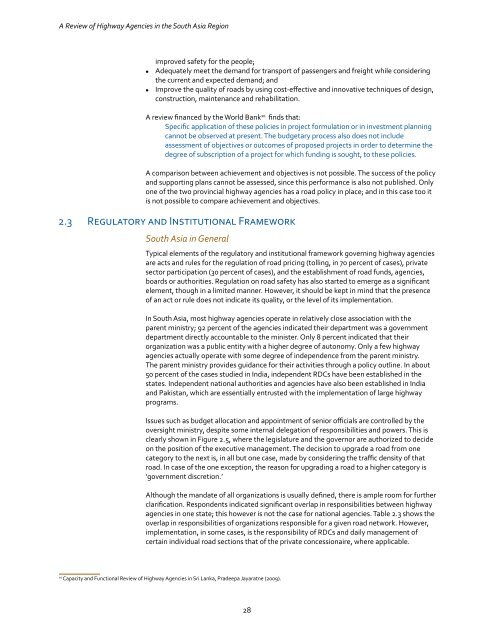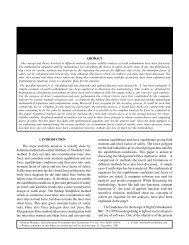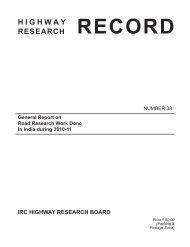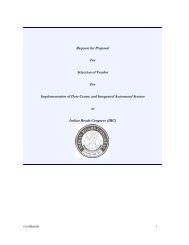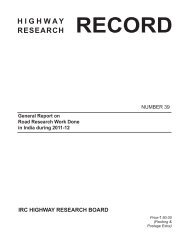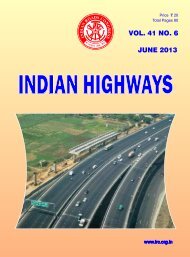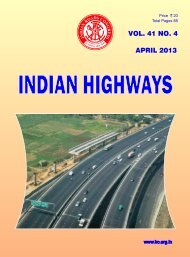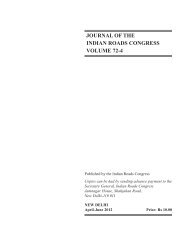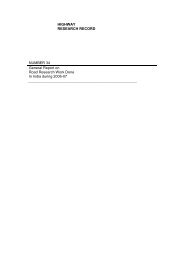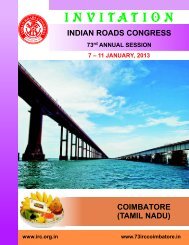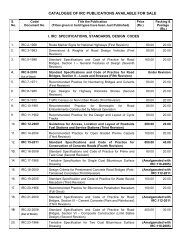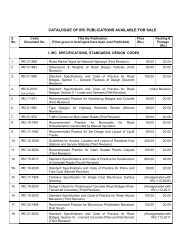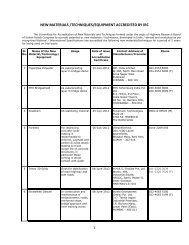A Review of Highway Agencies in the South Asia Region
A Review of Highway Agencies in the South Asia Region
A Review of Highway Agencies in the South Asia Region
You also want an ePaper? Increase the reach of your titles
YUMPU automatically turns print PDFs into web optimized ePapers that Google loves.
A <strong>Review</strong> <strong>of</strong> <strong>Highway</strong> <strong>Agencies</strong> <strong>in</strong> <strong>the</strong> <strong>South</strong> <strong>Asia</strong> <strong>Region</strong><br />
improved safety for <strong>the</strong> people;<br />
Adequately meet <strong>the</strong> demand for transport <strong>of</strong> passengers and freight while consider<strong>in</strong>g<br />
<strong>the</strong> current and expected demand; and<br />
Improve <strong>the</strong> quality <strong>of</strong> roads by us<strong>in</strong>g cost-effective and <strong>in</strong>novative techniques <strong>of</strong> design,<br />
construction, ma<strong>in</strong>tenance and rehabilitation.<br />
A review f<strong>in</strong>anced by <strong>the</strong> World Bank 10 f<strong>in</strong>ds that:<br />
Specific application <strong>of</strong> <strong>the</strong>se policies <strong>in</strong> project formulation or <strong>in</strong> <strong>in</strong>vestment plann<strong>in</strong>g<br />
cannot be observed at present. The budgetary process also does not <strong>in</strong>clude<br />
assessment <strong>of</strong> objectives or outcomes <strong>of</strong> proposed projects <strong>in</strong> order to determ<strong>in</strong>e <strong>the</strong><br />
degree <strong>of</strong> subscription <strong>of</strong> a project for which fund<strong>in</strong>g is sought, to <strong>the</strong>se policies.<br />
A comparison between achievement and objectives is not possible. The success <strong>of</strong> <strong>the</strong> policy<br />
and support<strong>in</strong>g plans cannot be assessed, s<strong>in</strong>ce this performance is also not published. Only<br />
one <strong>of</strong> <strong>the</strong> two prov<strong>in</strong>cial highway agencies has a road policy <strong>in</strong> place; and <strong>in</strong> this case too it<br />
is not possible to compare achievement and objectives.<br />
2.3 Regulatory and Institutional Framework<br />
<strong>South</strong> <strong>Asia</strong> <strong>in</strong> General<br />
Typical elements <strong>of</strong> <strong>the</strong> regulatory and <strong>in</strong>stitutional framework govern<strong>in</strong>g highway agencies<br />
are acts and rules for <strong>the</strong> regulation <strong>of</strong> road pric<strong>in</strong>g (toll<strong>in</strong>g, <strong>in</strong> 70 percent <strong>of</strong> cases), private<br />
sector participation (30 percent <strong>of</strong> cases), and <strong>the</strong> establishment <strong>of</strong> road funds, agencies,<br />
boards or authorities. Regulation on road safety has also started to emerge as a significant<br />
element, though <strong>in</strong> a limited manner. However, it should be kept <strong>in</strong> m<strong>in</strong>d that <strong>the</strong> presence<br />
<strong>of</strong> an act or rule does not <strong>in</strong>dicate its quality, or <strong>the</strong> level <strong>of</strong> its implementation.<br />
In <strong>South</strong> <strong>Asia</strong>, most highway agencies operate <strong>in</strong> relatively close association with <strong>the</strong><br />
parent m<strong>in</strong>istry; 92 percent <strong>of</strong> <strong>the</strong> agencies <strong>in</strong>dicated <strong>the</strong>ir department was a government<br />
department directly accountable to <strong>the</strong> m<strong>in</strong>ister. Only 8 percent <strong>in</strong>dicated that <strong>the</strong>ir<br />
organization was a public entity with a higher degree <strong>of</strong> autonomy. Only a few highway<br />
agencies actually operate with some degree <strong>of</strong> <strong>in</strong>dependence from <strong>the</strong> parent m<strong>in</strong>istry.<br />
The parent m<strong>in</strong>istry provides guidance for <strong>the</strong>ir activities through a policy outl<strong>in</strong>e. In about<br />
50 percent <strong>of</strong> <strong>the</strong> cases studied <strong>in</strong> India, <strong>in</strong>dependent RDCs have been established <strong>in</strong> <strong>the</strong><br />
states. Independent national authorities and agencies have also been established <strong>in</strong> India<br />
and Pakistan, which are essentially entrusted with <strong>the</strong> implementation <strong>of</strong> large highway<br />
programs.<br />
Issues such as budget allocation and appo<strong>in</strong>tment <strong>of</strong> senior <strong>of</strong>ficials are controlled by <strong>the</strong><br />
oversight m<strong>in</strong>istry, despite some <strong>in</strong>ternal delegation <strong>of</strong> responsibilities and powers. This is<br />
clearly shown <strong>in</strong> Figure 2.5, where <strong>the</strong> legislature and <strong>the</strong> governor are authorized to decide<br />
on <strong>the</strong> position <strong>of</strong> <strong>the</strong> executive management. The decision to upgrade a road from one<br />
category to <strong>the</strong> next is, <strong>in</strong> all but one case, made by consider<strong>in</strong>g <strong>the</strong> traffic density <strong>of</strong> that<br />
road. In case <strong>of</strong> <strong>the</strong> one exception, <strong>the</strong> reason for upgrad<strong>in</strong>g a road to a higher category is<br />
‘government discretion.’<br />
Although <strong>the</strong> mandate <strong>of</strong> all organizations is usually def<strong>in</strong>ed, <strong>the</strong>re is ample room for fur<strong>the</strong>r<br />
clarification. Respondents <strong>in</strong>dicated significant overlap <strong>in</strong> responsibilities between highway<br />
agencies <strong>in</strong> one state; this however is not <strong>the</strong> case for national agencies. Table 2.3 shows <strong>the</strong><br />
overlap <strong>in</strong> responsibilities <strong>of</strong> organizations responsible for a given road network. However,<br />
implementation, <strong>in</strong> some cases, is <strong>the</strong> responsibility <strong>of</strong> RDCs and daily management <strong>of</strong><br />
certa<strong>in</strong> <strong>in</strong>dividual road sections that <strong>of</strong> <strong>the</strong> private concessionaire, where applicable.<br />
10 Capacity and Functional <strong>Review</strong> <strong>of</strong> <strong>Highway</strong> <strong>Agencies</strong> <strong>in</strong> Sri Lanka, Pradeepa Jayaratne (2009).<br />
28


